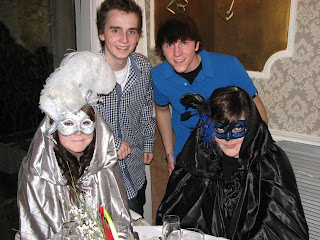CCI’s most recent trip to Venice and Verona was an exciting adventure for everyone. After an early departure from Lanciano last Friday, we arrived at our hotel in Venice during the mid-afternoon. It was a sunny afternoon and the beginning of what promised to be a remarkable experience for us all as Venice was prepared for its annual Carnevale.
We started our tours in the Piazza San Marco before beginning our tour of the Palazzo Ducale – the Doge’s Palace.
 |
Designed to impress foreign visitors and residents alike, the palace was the seat of government and the resident of its’ highest official, the Doge during the 400 year reign of the Venetians as one of the world’s great city state empires. The rooms inside are massive in scale and luxurious. Modern day visitors marvel at the many decorative paintings celebrating Venice’s power and influence in these rooms; and then tour rooms housing various weapons of war including armour, swords, pikes, clubs and even an early version of a machine gun. Then one only has to descend through the narrow corridors and staircases and peer into the damp and cold dungeons below to get a sense of the miserable lot that was that of Venetian prisoners.
Following some free time to explore Venice we all met back at the hotel for dinner.
Saturday was a busy day with the students taking tours in the morning and afternoon. The morning tours included the Gallerie Dell’Accademia, The Peggy Guggenheim Collection and a Mystery Tour. The afternoon tours saw a repeat of The Peggy Guggenheim Collection, the Mystery Tour as well as the new tour of the Tragicomica to see mask making.
The Peggy Guggenheim Collection is among the most important museums in Italy for European and American art of the first half of the 20th century. It is located in Peggy Guggenheim's former home, Palazzo Venier dei Leoni, on the Grand Canal in Venice.
Gallerie Dell’Accademia houses a very rich collection of paintings from the Byzantine era through to the 18th C by artists who have shaped Western art. Tragicomica is in fact a studio that manufactures masks and costumes using methods that have been in use for hundreds of years. The students learned about traditional masking making techniques and along with their teachers, modelled them for everyone else.
The Mystery Tour was a walking tour of parts of Venice that highlighted landmark churches neighbourhoods and buildings. Mr. Stephens and Mr. Knapp researched and created a tour in which they recounted stories and legends accorded to each of the places they stopped at. However, there was a catch. One of the stories was a fabrication and they challenged the students to guess which one was indeed their creation.
There was a grim reminder of the suffering of the Jewish people of Venice during WWII. Memorial plaques were placed on the wall that housed a door (seen at the right) through which some 300 people were, loaded onto trains that led to the camps.
As the day wore on, it was clear that Carnevale celebrations were evident. Carnevale has a long tradition throughout Italy but most famously in Venezia. It is celebrated in the period leading up to Ash Wednesday allowing people the opportunity to indulge before Lent. The wearing of masks and costumes levelled the social strata of Venice for this period allowing less affluent citizens to mix easily with the wealthiest in town. It also allowed for citizens to engage in activities that they otherwise wouldn’t. This annual festival had fallen into disfavour for a number of years as a consequence but was revived again in the 1980s under very strict guidelines, especially for the wearing of masks. As an indication of its popularity, the festival now has a pre-festival period for the Venetians a week ahead of the one for the many visitors who attend. This weekend alone some 55, 000 people flooded into Venice!
Early in the day it was easy to walk and navigate Venice’s narrow streets.
But by late in the afternoon, there were human traffic jams everywhere.
The Piazza San Marco was a particularly busy spot. When we gathered after lunch to regroup for the afternoon tours, our students and teachers were catching the spirit of the event.
Many of the costumed celebrants walked slowly and stopped often to pose for pictures taken by dozens of people jostling to get into position for a clear shot.
Some just stood there and posed while people photographed them.
The creativity, workmanship and detail of the masks and costumes were clearly evident.
Sunday morning saw us leaving Venice to drive south to Verona. This is very old town that dates to pre-Roman days.
A brass plaque on the main corso shows a map of the Verona in Roman times as it prominently displays the arena as well as the Piazza delle Erbe, the original Roman Forum.
The arena was built in the 1st C and is one of he best preserved in Italy today. Built outside of the city walls, the Romans used it for gladiatorial games. Later in the Middle Ages, it was mainly used for public executions including trials by combat. By the 18th C, its use was transformed to an opera centre but its walls are only half of their original height.
Verona is the setting for Shakespeare’s famous play Romeo and Juliet. While there are Italian stories that date to his time about two lovers from feuding families, there is no real evidence of historical accuracy to the story or to the location of their homes. Nevertheless, the old home, the balcony and play’s popularity draws thousands of visitors to see Casa di Giulietta;
and write love notes on the entrance wall;
and for some reason, park their gum there!
Following lunch, a walk through the streets and shops, our weary and wet troupe headed for Lanciano.











































































